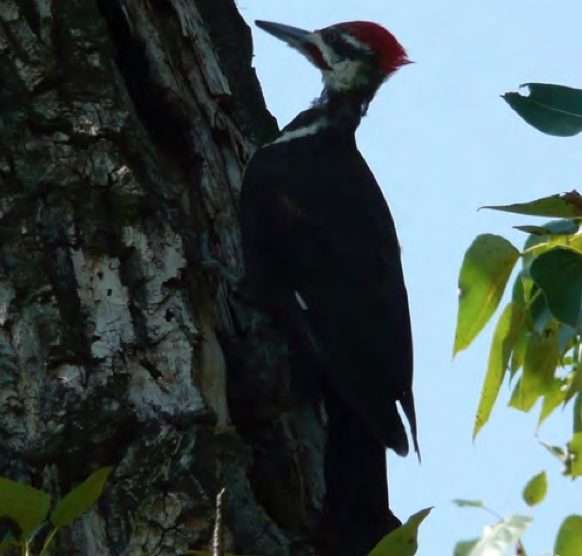When your dentist tells you there is a cavity in your mouth, a feeling of dread, maybe guilt may surface in your mind. However, in the forest the news that a new cavity has developed is reason to celebrate. Let me try to convince you to share a little love for the champion cavity maker of the parkland forests. Winter is an especially good time to spot them flying from tree to tree in the forest, pileated woodpeckers. This is easier to do at this time of year because one of the benefits of no leaves is high visibility.
The pileated woodpecker is our largest woodpecker at around 40 cm, about the size of a crow. It is always the size that catches my eye when I see it flitting through the woods or flying overhead. Although mostly black, it has beautiful white stripes on its face and both males and females sport a crest of red feathers. Males also have a red moustache. But let’s put aside looks for a moment and talk instead about the beauty of its role in our community.
Living up to its name, the pileated woodpecker carves holes in trees with its chiselled beak and amazing impact resistant head. Why “wood” this bird repeatedly slam its face into a tree at speeds that would surely kill other species? One reason is to get at those tasty carpenter ants which make up most of its diet. The other reason is to build a nest.
True romantics, the pileated woodpeckers mate for life and find a territory in which to carve out a new home, literally. Both male and females help to peck a hole into larger trees big enough to raise 3-5 young. These holes are called tree cavities. As the woodpeckers build their own home, they are called primary cavity nesters. Not only are they excellent carpenters to create such sturdy holes in trees, they are also a very tidy couple. Parents can be seen removing the poop of the young from the cavity with their beaks to ensure they stay clean; now that is next level parental care.
Every year the couple will build a new nest, abandoning a perfectly good cavity to go create another. Before you call “fowl” on what could be seen as unnecessarily destructive behaviour let’s look at the benefits. Very few species in the forest are equipped to chisel into trees and create safe nesting spaces for their young. The abandoned, but poop-free, holes are quickly occupied by secondary cavity nesters. These can include songbirds, squirrels, ducks, and even owls. By looking out for its own needs the pileated woodpecker creates conditions to fill the forest with cavities, which in turn supports other neighbouring species efforts to raise their families. This biodiversity (many different living things) enhances the health of the community as these species all have their own role to play in the ecosystem whether they be pollinators, seed dispersers, or predators. Finally, cavities we can all smile about. I wonder what it would be like if everyone provided for their community like the pileated woodpecker?
If you would like to try to find these community builders in your own yard look for large rectangle holes in trees, piles of woodchips at the base of trees or listen for sounds of knocking and its laughing call
in the forest.
Dedicated to the memory of Dr. Mal Blasetti- birder, dentist, & community builder
Laura Griffin

























